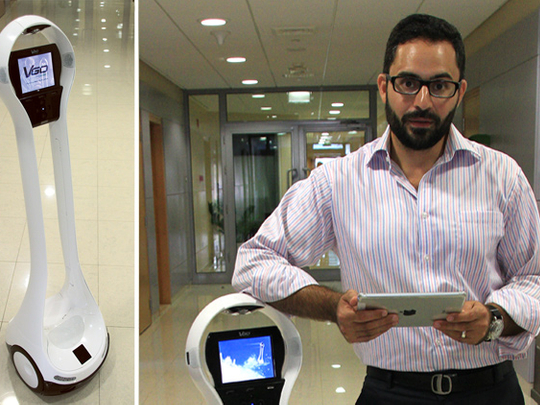
Dubai: A robot promises to change the way doctors and patients interact in certain UAE hospitals.
A next-generation robot, called VGo, is now being used to enhance patient-doctor interface and help manage hospitals better.
The sophisticated communication robot, developed by a US venture capital company, allows a healthcare provider, patient or family member to have "telepresence" -- to be virtually at a patient's bedside even if they are actually distant.
They can move around in that location as if they are next to the patient.
BY allows doctors from around the world to "telecommunicate", it helps lower costs of patient care. It also provides an emotional anchor to family members who are able to "stay" with their loved ones admitted to a hospital for long stretches of time.
Introduced in the UAE by Amana Healthcare, a medical and rehabiliation hospital with an 80-bed facility in Al Ain and Abu Dhabi city, VGo could change the lives of children with congenital anomalies who are confined to living at medical centres.
It is the next best alternative to actually being in the clinic, hospital, rehabilitation centre or assisted living facility, Ali A. Hashemi, director of Amana, said.
At five feet tall and 13 inches wide, the device works on Wi-Fi and broadband networks and is fitted with high-resolution manoeuvrable camera.
Take the case of Mohammad K. (not his real name), an Emirati child with a congenital condition living at an assisted medical centre in the UK.
His parents were keen he returns and, with VGo, he was able to take a virtual tour of the hospital, meet the doctors, nurses and other caregivers who will be working with him, see his bed and actually feel comfortable before he moved into this place.
“VGo eliminates the deficiencies associated with other video solutions that are locked to a TV or computer monitor by providing 100 per cent remote-controlled mobility,” Hashemi said.
How it works
The remote-controlled robot, which costs approximately Dh40,000, facilitates user interface with high quality video images and sharp audio. It combines two elements: The VGo robot and the VGo App that can be downloaded to the iPad or laptop of someone wishing to establish communication. It runs on a special cloud commuting network.
All the user needs to do is bring up the VGo App on his/her computer, click the location where he needs to be and he can see, hear, talk, be heard and seen and move anywhere in that location.
Hashemi feels VGo is helping enhance healthcare in a big way.
“It has made management of patients much better with sophisticated communication. We are in touch with the creators of this robot who continue to provide us maintenance support. With our feedback the robot is going to evolve and add embellishments in its next avatar.”












